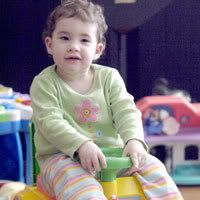
By CANDACE BEATY Staff writer Oct. 9 ,2006
When 2-year-old Taegan McFarland crawls into the treatment chamber in her Greenwood home, it's called a tent. For her mom, Michelle McFarland, it's a machine that could help her little girl lead a more normal life.
Hyperbaric oxygen treatments are often used by athletes to speed recovery from injuries and by people with diabetes. Taegan uses it to treat her cerebral palsy.
The machine increases the barometric pressure inside the chamber, which allows a higher level of oxygen than the air we breathe to be pumped in.
The portable machine reaches a 37 percent level of oxygen, encouraging blood flow, McFarland said. Regular air contains 21 percent oxygen.
The treatment allows more oxygen to reach more areas of the body, she said. The increase in oxygen allows dormant cells in Taegan's brain to became active.
After 11 one-hour sessions in the machine, McFarland said she could see considerable improvements in Taegan, who is 12 months to 15 months behind her peers developmentally.
Taegan may squirm a little as she crawls into her tent, but once inside she enjoys looking at her picture books, McFarland said.
The chamber is just large enough for McFarland to accompany her daughter to make sure she is OK. McFarland lies on her stomach while Taegan sits up at one end.
Taegan's type of cerebral palsy causes her to have stiff muscles in her legs. She wears leg braces to help get her feet flat on the ground, because the stiffness causes her feet to point straight down.
Her type of cerebral palsy also is linked with periventricular leukomalacia, which causes swelling in parts of her brain.
Taegan undergoes various physical therapy treatments weekly. Her mother said Taegan has faced developmental problems since complications led to her birth two months early.
When Taegan's doctors said she had cerebral palsy in August, McFarland started researching online for different treatment options. That's when she found information about the treatment, which she said many of Taegan's doctors knew little about.
Before Taegan started using the treatment, she would only take a few steps. Now, she walks across the living room, McFarland said. Taegan also started trying to talk more.
Her physical therapist, Joanna McGill, has noticed changes, too.
Taegan gained movement in her left ankle, her biggest problem area, McGill said. Before the treatments, Taegan would scream and cry when doing stretches on her legs. Now, Taegan has become more comfortable with the stretches and can put both heels on the ground, McGill said.
Despite the treatment's apparent success, McFarland said insurance companies don't cover the process. Hospitals also don't use it the treat cerebral palsy.
Since McFarland couldn't afford the treatments, she started saving money and looking into fund-raisers. A complete treatment of 40 one-hour sessions will cost at least $4,000, she said.
"You're just willing to try anything you can to help your child be the best they can be," she said.
Before she could raise enough money to fund the treatments, a friend's acquaintance heard about her plight and lent a portable machine for Taegan to use.
"It was divine intervention from God that brought it to me," McFarland said.
A friend knew someone in Ohio who bought a chamber for his wife to treat her diabetes. The friend asked if the McFarlands could come to his house and use the chamber.
Instead, the man allowed the McFarlands to keep it for three weeks.
The treatment can be done with portable chambers or at some hospitals. The hospitals' chambers are larger and fill with 100 percent oxygen, compared to the portable chamber's 37 percent.
The McFarlands returned the chamber to its owner Saturday. Now, McFarland is looking for ways to continue the treatments.
Taegan used the chamber 11 times, less than half the length of a usual treatment.
McFarland started a couple of Web sites hoping to find someone to help pay for the medical bills.
Michelle and her husband Shawn McFarland have struggled financially since she was put on bed rest during pregnancy and had to quit working. With medical bills that insurance wouldn't cover piling up, Shawn works two jobs to make ends meet.
While various treatments have helped Taegan, it's too early to tell what development problems she may face, Michelle McFarland said. She may face vision and hearing problems, continuing developmental delay or seizures.
McFarland hopes she can continue the treatment for Taegan while she is young. Since her body is still developing, treatments before the age of 5 will be the most effective, she said.
"I have high hopes that this will help her so it lessens her physical limitations," she said.
AT A GLANCE
What is hyperbaric oxygen treatment?
The treatment consists of placing the patient in an enclosed chamber with increased atmospheric pressure and a higher oxygen level. The portable treatment chamber Taegan used raises the oxygen level to 37 percent. Chambers at hospitals or treatment centers are filled with pure oxygen.
The increased oxygen allows areas of the body that don't usually get a lot of oxygen more access to it. The increased oxygen helps decrease swelling, encourage blood flow and promote new blood vessel growth.
Who uses it?
At hospitals, the treatment is used to treat carbon monoxide poisoning, exceptional blood loss, cyanide poisoning, burns and some other conditions.
Elsewhere, the treatment is used to treat a wide range of conditions, including cerebral palsy, strokes, multiple sclerosis, heart attacks, fatigue, attention deficit disorder, autism, cancer and sports injuries.
For cerebral palsy patients, the oxygen helps decrease swelling in the brain and helps more blood reach it.
SOURCES: Michelle McFarland and The Cole Center for Healing


No comments:
Post a Comment